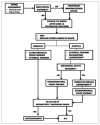Predictive factors of mortality in patients with pelvic fracture and shock submitted to extraperitoneal pelvic packing
- PMID: 36197344
- PMCID: PMC10578839
- DOI: 10.1590/0100-6991e-20223259-en
Predictive factors of mortality in patients with pelvic fracture and shock submitted to extraperitoneal pelvic packing
Abstract
Introduction: in recent decades, the extraperitoneal pelvic packing technique has been disseminated, but there are still few studies. Thus, it was decided to analyze the results of extraperitoneal pelvic tamponade, in patients with pelvic fracture and shock, in order to identify predictive factors for mortality.
Methods: a retrospective review of medical records of patients submitted to extraperitoneal pelvic packing was conduced. We analyzed their characteristics, prehospital and emergency room data, pelvic fracture classification, associated and severity injuries, laboratory and imaging exams, data on packing, arteriography, and other procedures performed, complications, hemodynamic parameters, and amount of transfused blood products before and after packing.
Results: data were analyzed from 51 patients, who showed signs of shock from prehospital care, presence of acidosis, with high base deficit and arterial lactate levels. Most patients underwent multiple surgical procedures due to severe associated injuries. The incidence of coagulopathy was 70.58%, and overall mortality was 56.86%. The group of non-surviving patients presented significantly higher age, prehospital endotracheal intubation, and lower Glasgow Coma Scale scores (p<0.05). The same group presented, before and after extraperitoneal pelvic packing, significantly worse hemodynamic parameters of mean arterial pressure, pH, base deficit, hemoglobin, and arterial lactate (p<0.05). The non-surviving group received significantly more units of packed red blood cells, fresh frozen plasma and platelets within 24 hours following extraperitoneal pelvic packing (p<0.05).
Conclusion: age and base deficit are independent predictors of mortality in patients submitted to extraperitoneal pelvic packing.
Introdução:: nas últimas décadas, tem sido difundida a técnica de tamponamento pélvico extraperitoneal, porém ainda existem poucos estudos. Decidiu-se analisar os resultados do tamponamento extraperitoneal de pelve, em pacientes com fratura pélvica e choque, com objetivo de identificar fatores preditivos de mortalidade.
Métodos:: foi realizada revisão do prontuário dos pacientes submetidos ao tamponamento extraperitoneal de pelve. Foram analisadas as características dos pacientes, dados do atendimento pré-hospitalar e na sala de emergência, classificação da fratura, presença de lesões associadas, exames laboratoriais e de imagem, dados relativos ao tamponamento, e outros procedimentos realizados, complicações, parâmetros hemodinâmicos e quantidade de hemoderivados transfudidos.
Resultados:: foram analisados os dados de 51 pacientes, com sinais de choque desde o atendimento pré-hospitalar, presença de acidose, elevado déficit de bases e lactato arterial. Houve alta prevalência de lesões graves associadas, requerendo múltiplos procedimentos cirúrgicos. A incidência de coagulopatia foi 70,58% e mortalidade 56,86%. O grupo de pacientes não sobreviventes apresentou idade e intubação orotraqueal pré-hospitalar maiores, e escores na escala de coma de Glasgow menores (p<0,05). O mesmo grupo apresentou, antes e após o tamponamento extraperitoneal de pelve, parâmetros hemodinâmicos menores de pressão arterial média, pH, déficit de bases e hemoglobina, e maior de lactato arterial (p<0,05). O grupo de pacientes não sobreviventes recebeu mais concentrados de hemácias, plasma fresco congelado e concentrado de plaquetas nas 24h seguintes ao tamponamento extraperitoneal de pelve (p<0,05).
Conclusão:: idade e o excesso de bases são fatores preditivos independentes de mortalidade em pacientes submetidos ao tamponamento extraperitoneal de pelve.
Conflict of interest statement
Conflict of interest: no.
Figures


References
MeSH terms
Substances
LinkOut - more resources
Full Text Sources
Medical

